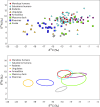Stable isotope evidence for pre-colonial maize agriculture and animal management in the Bolivian Amazon
- PMID: 39715871
- PMCID: PMC11936833
- DOI: 10.1038/s41562-024-02070-9
Stable isotope evidence for pre-colonial maize agriculture and animal management in the Bolivian Amazon
Erratum in
-
Author Correction: Stable isotope evidence for pre-colonial maize agriculture and animal management in the Bolivian Amazon.Nat Hum Behav. 2025 Mar;9(3):625. doi: 10.1038/s41562-025-02101-z. Nat Hum Behav. 2025. PMID: 39779894 Free PMC article. No abstract available.
Abstract
Over the past decade, multidisciplinary research has seen the Amazon Basin go from a context perceived as unfavourable for food production and large-scale human societies to one of 'garden cities', domestication, and anthropogenically influenced forests and soils. Nevertheless, direct insights into human interactions with particular crops and especially animals remain scarce across this vast area. Here we present new stable carbon and nitrogen isotope data from 86 human and 68 animal remains dating between CE ~700 and 1400 from the Llanos de Mojos, Bolivia. We show evidence of human reliance on maize agriculture in the earliest phases before a reduction in the dietary importance of this crop between CE 1100 and 1400. We also provide evidence that muscovy ducks (Cairina moschata), the only known domesticated vertebrate in the South American lowlands, had substantial maize intake suggesting intentional feeding, or even their domestication, from as early as CE 800. Our data provide insights into human interactions with Amazonian ecosystems, including direct evidence for human management of animals in pre-colonial contexts, further enriching our understanding of human history in what was once considered a 'counterfeit paradise'.
© 2024. The Author(s).
Conflict of interest statement
Competing interests: The authors declare no competing interests.
Figures



Similar articles
-
Stable isotope evidence for the adoption of maize agriculture.Curr Anthropol. 2009 Oct;50(5):633-40. doi: 10.1086/605111. Curr Anthropol. 2009. PMID: 20642150
-
Reconstruction of human subsistence and husbandry strategies from the Iberian Early Neolithic: A stable isotope approach.Am J Phys Anthropol. 2018 Oct;167(2):257-271. doi: 10.1002/ajpa.23622. Epub 2018 Aug 20. Am J Phys Anthropol. 2018. PMID: 30129180
-
Quinoa, potatoes, and llamas fueled emergent social complexity in the Lake Titicaca Basin of the Andes.Proc Natl Acad Sci U S A. 2021 Dec 7;118(49):e2113395118. doi: 10.1073/pnas.2113395118. Proc Natl Acad Sci U S A. 2021. PMID: 34845028 Free PMC article.
-
The sleeping crops of eastern North America: a new synthesis.Philos Trans R Soc Lond B Biol Sci. 2025 May;380(1926):20240192. doi: 10.1098/rstb.2024.0192. Epub 2025 May 15. Philos Trans R Soc Lond B Biol Sci. 2025. PMID: 40370024 Free PMC article. Review.
-
Contrasting patterns in crop domestication and domestication rates: recent archaeobotanical insights from the Old World.Ann Bot. 2007 Nov;100(5):903-24. doi: 10.1093/aob/mcm048. Epub 2007 May 10. Ann Bot. 2007. PMID: 17495986 Free PMC article. Review.
Cited by
-
Constraining the population size estimates of the pre-Columbian Casarabe Culture of Amazonian Bolivia.PLoS One. 2025 May 30;20(5):e0325104. doi: 10.1371/journal.pone.0325104. eCollection 2025. PLoS One. 2025. PMID: 40446060 Free PMC article.
References
-
- Meggers, B. J. Environmental limitation on the development of culture. Am. Anthropol.56, 801–824 (1954).
-
- Meggers, B. J. Amazonia: Man and Culture in a Counterfeit Paradise (Smithsonian Institution Press, 1971).
-
- Lathrap, D. W. The Upper Amazon (Thames & Hudson, 1970).
-
- Gross, D. R. Protein capture and cultural development in the Amazon Basin. Am. Anthropol.77, 526–549 (1975).
Publication types
MeSH terms
Substances
LinkOut - more resources
Full Text Sources
Miscellaneous

